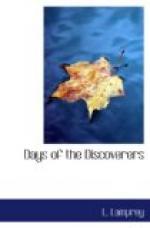To the sons of Norman and Breton peasants it was evident that these fields had not been cultivated for centuries, like those of France, any more than the wall around Hochelaga was the work of stone-masons toiling under generations of feudal lords. If this were the chief city of these people, they had no Norumbega. But it was very picturesque in its sylvan barbaric way, among the limitless forests of scarlet and gold and crimson and deep green, which stretched away over the mountains. Upon the rude cots in the wigwams as they passed, Cartier’s men saw rich and glossy furs of the silver fox, the beaver, the mink and the marten, which princesses might be proud to wear. Curious bead-work there was also on the quivers, pouches, moccasins and belts of these wild people, done in white and purple shell beads made and polished by hand and not more than a quarter of an inch long and an eighth of an inch thick. These were sewn in patterns of animals, birds, fishes and other things not unlike the emblems of old families in France. Belts of these beads were worn by those who seemed to be the chief men of Hochelaga. Porcupine quills were also used in embroidery and head-bands.
The people thronged into the open central space, which was about a stone’s throw across, some carrying their sick, some their children, that the strangers might touch them for healing or for good fortune. The old chief, who was called Agouhana, was brought in, helpless from paralysis, upon a deerskin litter. When Cartier understood that his touch was supposed to have some mysterious magic he rubbed the old man’s helpless limbs with his own hands, read from his service-book the first chapter of the Gospel of Saint John and other passages, and prayed that the people who listened might come to know the true faith. Then, after beads, rings, brooches and other little gifts had been distributed, the trumpets blew, and the white men took their leave. Before they returned to their boats the Indians guided them to the top of the hill which rose behind the town, from which the surrounding country could be seen. Cartier named it Montreal—the Royal Mountain.
[Illustration: “CARTIER READ FROM HIS SERVICE-BOOK.”—Page 176]
It was now the first week in October, and the rapids in the river above Hochelaga blocked further exploration with a sailing vessel. As for going on foot, that was out of the question with winter so near. The party returned to Stadacona and went into winter quarters. While they had been gone their comrades had built a palisaded fort beside the little river where the ships lay moored. They were hardly settled in this rude shelter before snow began to fall, and seemed as if it would go on forever, softly blanketing the earth with layer on layer of cold whiteness. It was waist-deep on the level; the river was frozen solid; the drifts were above the sides of the ships, and the ice was four inches thick on the bulwarks. The glittering armor of the ice incased masts, spars, ropes, and fringed every line of cordage with icicles of dazzling brightness. Never was such cold known in France. Maclou thought, whimsically, while his teeth chattered beside the fire, of a tale he had once told Marguerite of the palace of the Frost King. That fierce monarch, and not the guileless Indian chief, was the foe they would have to fight for this kingdom.




